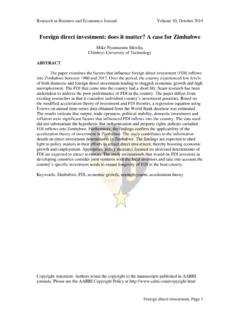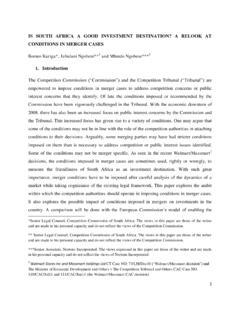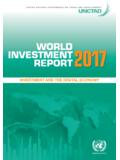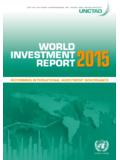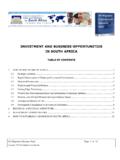Transcription of Gross Domestic Product - OECD
1 This fact sheet provides a snapshot of key economic indicators in africa since 2005. It includes statistics and analysis for GDP, the structure of African economies, foreign trade, foreign direct investment, official development assistance, external debt and remittances. 2005 2006 2007 2008 2009 2010* GDP per Capita (in 2005 US$) 1 057 1 094 1 132 1 161 1 162 1 189 Annual GDP Growth (% change) GDP, Share of World (%) Gross Domestic Product From of annual GDP growth between 2005 and 2008, africa s economies grew only in 2009.
2 However, the UN projects a healthier growth rate of in 2010, signaling a relatively rapid recovery from the crisis. On a country level, africa boasts some of the worlds biggest growth success stories. Over the last ten years, no fewer than six of the world s ten fastest-growing economies were in Sub-Saharan africa . This fact sheet is jointly published by the United Nations Office of the Special Advisor on africa (OSAA) and the NEPAD-OECD africa Investment Initiative. They are available at , and at For more information, please contact: David Mehdi Hamam, Chief (OSAA) at or Karim Dahou, Executive Manager (NEPAD-OECD Initiative) at Source: Based on UNDESA World Economic Situation and Prospects 2010 *Projections africa Fact Sheet GDP in africa 2 Structure of African Economies African economies rely heavily on agriculture.
3 For Sub-Saharan africa , the agriculture sector s share in GDP was in 2009, and provided employment to more than 60% of the labor force. Globally, agriculture s share in GDP is only On the other hand, the contribution of manufacturing to African countries GDP is smaller than the global average. Growth of informal activities and rapid urbanization is responsible for the sizeable share of the services sector, which can therefore not be interpreted as a maturing of African economies.
4 This is particularly striking when considering that ODA flows to africa reached US$ 44 billion in 2008, only half of FDI inflows. foreign investors can provide many benefits to African economies: in addition to bringing more capital, tax revenues, exports and export diversification, foreign investors can also inject new technologies and corporate know-how into the local economy through fostering close linkages with local suppliers. For FDI to contribute fully to economic and social progress in africa , host-country governments need to create a policy environment that enables them to maximize development returns on investment.
5 Governments should thus develop a set of policies that are not only focused on investment promotion, but also address issues such as human capital, infrastructure and enterprise development, and are likely to increase FDI spillover effects and contribute to economic diversification. This is all the more important because FDI in africa , with a share of about 5% of global flows, remains small compared to flows to and among industrialised and major emerging Although the natural resources sector is traditionally a major recipient of FDI flows to africa , high-value activities in services and manufacturing have recently attracted important investments.
6 In addition, the food crisis has stimulated foreign investors interest in africa s arable land. The agricultural sector has faced scant investment leading to low productivity in the past, and a rapid increase in global and Domestic demand in recent years. At this crucial juncture, the continent is now presenting itself as a new frontier for FDI. foreign Trade africa remains marginalied in global trade. In 2009, it accounted for only 3% of world merchandise exports, corresponding roughly to its share in global GDP.
7 At the same time, African trade is more outward-oriented than in any other continent only around 12% of its total merchandise trade is directed to intra-regional trade. 2005 2006 2007 2008 2009 Agriculture Industry (incl. Mining and Manufacturing) Manufacturing Services Source: Based on World Bank World Development Indicators 2010 Database 2005 2006 2007 2008 2009 Merchandise Exports (US$ billions) 309 362 424 555 374 Merchandise Imports (US$ billions) 252 291 368 481 405 Exports, Share of World Total (%) Imports, Share of World Total (%) Share of Intra-regional Trade (%) Source.
8 Based on UNCTAD Handbook of Statistics 2010 Sectoral share of GD in Sub-Saharan africa , in percent Source: Based on World Bank World Development Indicators 2010 Database Trade indicators in africa 3 foreign direct Investment Over the past two decades foreign direct Investment (FDI) has become a vital source of funding and economic development for the African continent, increasing from approximately US$6 billion in 1995 to US$ billion in 2008. However, FDI remained concentrated in resource extraction.
9 The global financial and economic crisis also dampened global investment flows into africa . After the record high of 2008, the continent saw its FDI inflows fall to US$ billion in 2009. This marked the end of six years of consecutive increases in FDI flows to africa . Total investment as a percentage of GDP has remained stable in africa in recent years: it slightly increased in relative terms, from in 2005 to of GDP in 2008. Official Development Assistance Official Development Assistance (ODA) to africa has increased markedly in recent years.
10 Expressed in current prices, in 2006 africa received US$44 billion in ODA, spurred by massive debt relief efforts. ODA fell to US$ billion in 2007, but reached a new record high of an estimated US$ billion in 2009. Despite that increase, ODA to africa is falling short of the targets set. Since 2004, africa has received between 32 and 35% of the total increase in ODA, well below the 50% increase committed to at the 2005 G8 Summit in Gleneagles. The top five bilateral donors to africa in 2009 were the United States, France, the United Kingdom, Germany, and the Netherlands.












